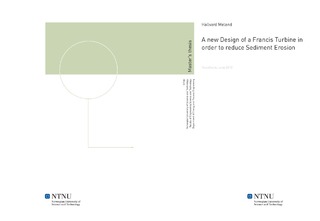A new Design of a Francis Turbine in order to reduce Sediment Erosion
Master thesis
Permanent lenke
http://hdl.handle.net/11250/233701Utgivelsesdato
2010Metadata
Vis full innførselSamlinger
Sammendrag
This Master Thesis is about the sand erosion challenges with the Francis turbines. The background for studying this subject is the fact that the sand erosion problem is a very negative factor for the development of new hydro electric power plants in many developing countries. The target with this Master Thesis has been to develop a new design, a revised version of the Francis turbine, reducing the sand erosion by 30- 50 per cent compared with today´s version of turbines. The present version of Francis turbines is consisting of three different vane cascades, The stay, guide and runner cascade. The sand erosion is in proportion with the relative speed between the sand particles and the steel cubed. This challenge has thus been analyzed and solved by reducing this speed through the turbine. Regarding the stay vanes, a new design has been proposed where the stay vanes are pressing the spiral casing from outside and not from the inside. This will result in the fact that the whole sand erosion problem has been removed. It has been proposed to remove the the guide vane cascade. This will consequently remove the sand erosion problem here as well. A favourable solution is to increase the reaction degree. For the runner a study of four different parameters has been carried out. These parameters were the number of pole pair in the generator, outlet angle, reaction degree and UCu distribution. The analysis shows that a reduction of sand erosion at the runner outlet was possible by selecting a higher number of pole pair along with a higher outlet angle than what is standard practice today. This result is of high significant importance since the sand erosion is biggest at the runner outlet. A change in the reaction degree may enable the erosion at the inlet of the runner, whereas a change in the UcU will change the erosion between the inlet and outlet. By selecting favourable parameter values, a substantial reduction of sand erosion in a Francis turbine will be possible. The turbines in this Master thesis have been designed in the computer program Matlab. A proposal for new design based upon the results of the parameter study has been analyzed in a CDF analysis. This analysis has been made in Ansys CFX.
